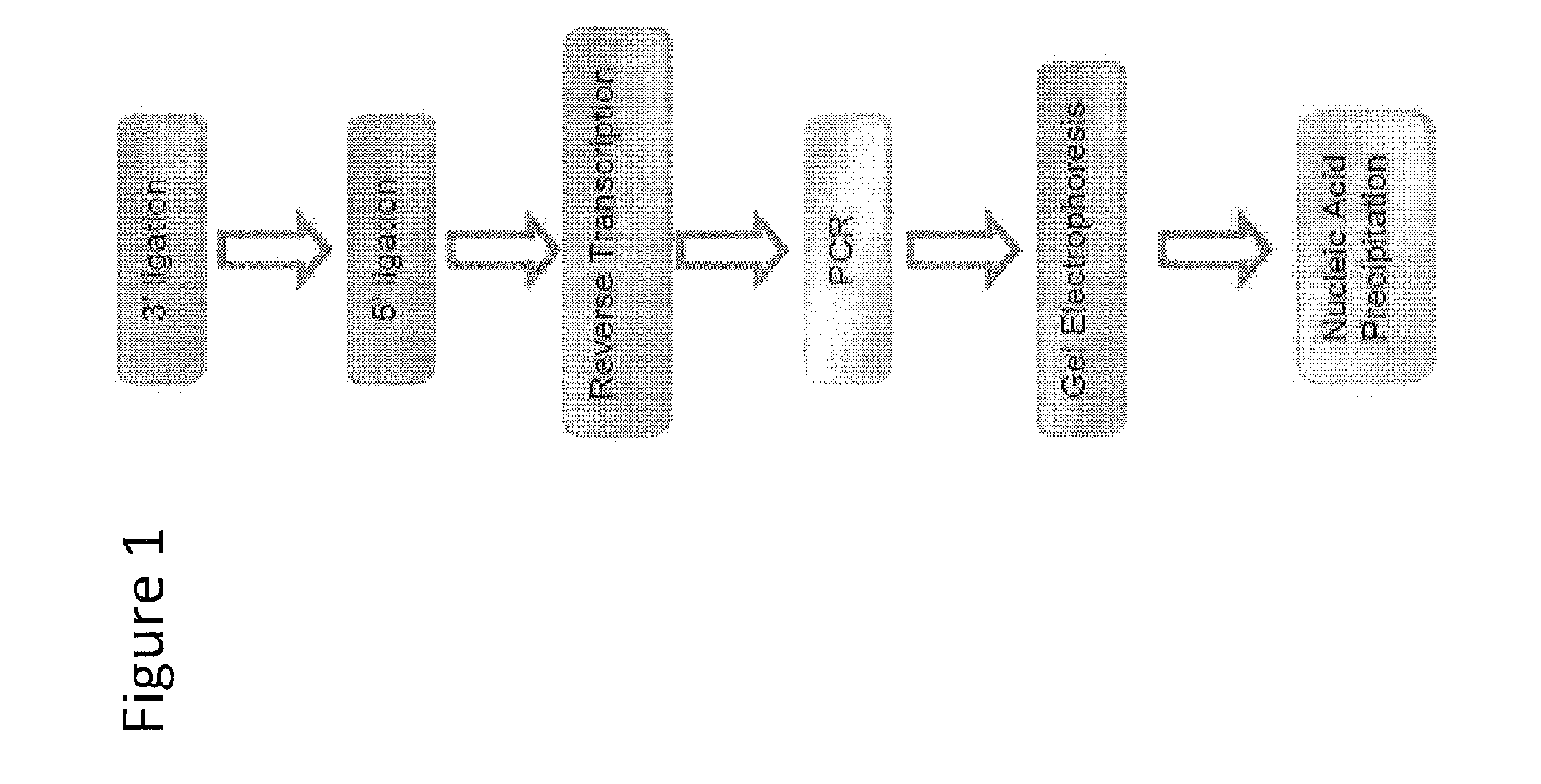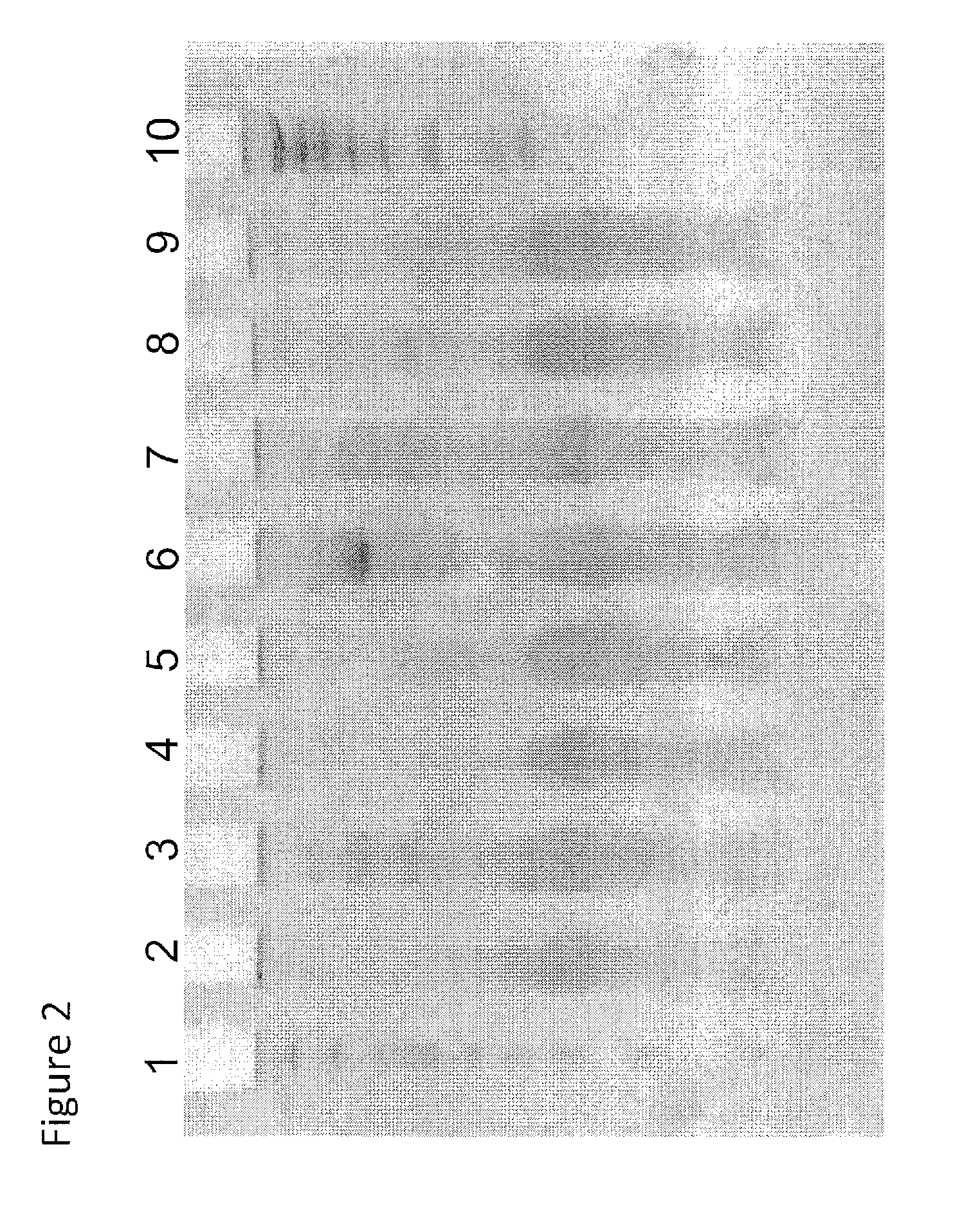Oligonucleotide ligation, barcoding and methods and compositions for improving data quality and throughput using massively parallel sequencing
a technology of oligonucleotide ligation and barcoding, applied in the field of novel methods and compounds for ligation and barcoding oligonucleotide sequences, can solve the problems of re-amplifying, re-fragmentation, and difficulty in distinguishing taq errors
- Summary
- Abstract
- Description
- Claims
- Application Information
AI Technical Summary
Benefits of technology
Problems solved by technology
Method used
Image
Examples
example i
[0043]Protocol for enhanced ligation of an oligonucleotide of known sequence to an oligonucleotide whose sequence is unidentified using AIR Ligase with enhanced buffer conditions consisting of 50 mM TrisHCl, pH 7.5, 10 mM MgCl2 and 5 mM DTT.
Step 1
3′ Adapter Ligation
Materials:
[0044]10 μM stock of AIR Barcoded Adapters (Bioo Scientific Cat.# 510501)
10×AIR™ Ligase Buffer (T4 RNA Ligase 2, truncated) (Bioo Scientific Cat.# 512105)
AIR™ Ligase (T4 RNA Ligase 2, truncated) (Bioo Scientific Cat.# 512105)
RNA (1-10 μg of total RNA or isolated small RNA) (Bioo Scientific Cat.# 5155-5182)
50% PEG (MW 4000)
RNaseOUT (Invitrogen)
[0045]RNase free H2O (Bioo Scientific Cat.# 801001)
1. Combine the following separately for EACH AIR Barcoded adapter:
μLRNA (total RNA or isolated small RNA may be used) 2 μLAIR ™ Barcoded Adapter (10 μM) 2 μL10× AIR™ Ligase buffer4.8 μL50% PEG (MW 4000) 1 μLRNaseOUT μLH2O 20 μLTOTAL
2. Heat at 95° C. for 30 seconds and immediately place on ice for 2 minutes
3. Add to ea...
example ii
[0089]Sample barcodes where the 3′ end of the 5′ adapter can be any sequence described in the claims. Degenerate sequence here is illustrated as an example, any degenerate sample that matches with a particular sequencing platform can be substituted here in place of the below sequences.
Sequencing Set #13′ adapterAAGTATCGTATGCCGTCTTCTGCTTGATCCTTCGTATGCCGTCTTCTGCTTGAGAGGTCGTATGCCGTCTTCTGCTTGACTACTCGTATGCCGTCTTCTGCTTGAACGTTCGTATGCCGTCTTCTGCTTGATACATCGTATGCCGTCTTCTGCTTGAGCTGTCGTATGCCGTCTTCTGCTTGACGCCTCGTATGCCGTCTTCTGCTTGAATAGTCGTATGCCGTCTTCTGCTTGTAGGTTCGTATGCCGTCTTCTGCTTGTCTCTTCGTATGCCGTCTTCTGCTTGTTGTTTCGTATGCCGTCTTCTGCTTGTAAATTCGTATGCCGTCTTCTGCTTGTGCATTCGTATGCCGTCTTCTGCTTGTCACTTCGTATGCCGTCTTCTGCTTGTTCTTTCGTATGCCGTCTTCTGCTTGTATGTTCGTATGCCGTCTTCTGCTTGTCCATTCGTATGCCGTCTTCTGCTTGCACTCTCGTATGCCGTCTTCTGCTTGCTGCCTCGTATGCCGTCTTCTGCTTGCGTAATCGTATGCCGTCTTCTGCTTGCCATATCGTATGCCGTCTTCTGCTTGCCTGTTCGTATGCCGTCTTCTGCTTGCGATTTCGTATGCCGTCTTCTGCTTGCTCAGTCGTATGCCGTCTTCTGCTTGCAGCGTCGTATGCCGTCTTCTGCTTGCATGATCG...
PUM
| Property | Measurement | Unit |
|---|---|---|
| temperature | aaaaa | aaaaa |
| temperature | aaaaa | aaaaa |
| pH | aaaaa | aaaaa |
Abstract
Description
Claims
Application Information
 Login to View More
Login to View More - R&D
- Intellectual Property
- Life Sciences
- Materials
- Tech Scout
- Unparalleled Data Quality
- Higher Quality Content
- 60% Fewer Hallucinations
Browse by: Latest US Patents, China's latest patents, Technical Efficacy Thesaurus, Application Domain, Technology Topic, Popular Technical Reports.
© 2025 PatSnap. All rights reserved.Legal|Privacy policy|Modern Slavery Act Transparency Statement|Sitemap|About US| Contact US: help@patsnap.com



